

We examined over 800 European cities’ plans to tackle climate change. Here’s what we found. Around the world, cities endeavour to cut greenhouse gas emissions, while adapting to the threats – and opportunities – presented by climate change.

It’s no easy task, but the first step is to make a plan outlining how to meet the targets set out in the Paris Agreement, and help limit the world’s mean temperature rise to less than two degrees Celsius above pre-industrial levels. About 74 per cent of Europe’s population lives in cities, and urban settlements account for 60-80 per cent of carbon emissions – so it makes sense to plan at an urban level. Working to meet carbon reduction targets can also reduce local pollution and increase energy efficiency – which benefits both businesses and residents. In the most comprehensive survey to date, we collaborated with 30 researchers across Europe to investigate the availability and content of local climate plans for 885 European cities, across all 28 EU member states. Map of cities with local climate plans (LPCs). The leaderboard. Why charges are not enough to bin throwaway culture: News: www.nus.org.uk. Student journalist Hollie Ryan considers the potential and problems of charging people for using disposible products, like coffee cups - and argues we need a multipronged approach to achieve true change.

When the 5p charge on plastic bags was first introduced, I worked in a department store and experienced the change from a customer-service perspective. Alongside government policy, the social interaction between those selling products and the consumer is a key factor in changing unsustainable behaviour habits, but often goes unacknowledged and undervalued. Therefore, when future charges are introduced to prevent consumers using disposable products, it’s important to focus on what comes alongside these economic changes to the market. According to the Environmental Audit Committee, just 0.25% of the 2.5 billion coffee cups, used in the UK each year, are recycled. FoodMovementsWinter2010bckgrndr. Can urban agriculture reduce food insecurity for the urban poor? — Sydney Environment Institute. According to the Food and Agriculture Organisation, food insecurity is a lack of secure access to sufficient and nutritious food required for normal growth, development and a healthy lifestyle (Napoli, 2011:9).
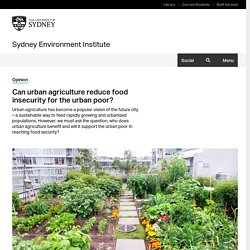
Food insecurity can occur from a range of factors, including inadequate housing and basic infrastructure, limited access to services, insufficient income, increasing food prices, lifestyle changes (food producers become paying consumers) and gender disparities. 17 Organizations Fighting the Global Hunger Increase. Is Capitalism a Barrier to Food Justice? No consumer, farmer, or activist participates in the food system without also participating in capitalism.

To Eric Holt-Giménez, the director of Food First, this is a basic truth that’s too often overlooked in the struggle to change our broken food system. In his new book, A Foodie’s Guide to Capitalism, Holt-Giménez delineates the basic truths of capitalism and how they are connected to the history of our food system. Part history book, part practical guide, the book links many of the injustices associated with food to other inequities, arguing that capitalism fuels and is fueled by oppression. If we better understand “the rudiments of how capitalism operates,” he explains, “we can better grasp why our food system is the way it is, and how we can change it.” Civil Eats spoke with Holt-Giménez recently about the book, the current food crisis, and the future of food activism. Elderly people get lost because internal GPS goes haywire with age, scientists find Living Near Greenery Keeps Elderly People's Minds Young. If you're worried about dementia or a more subtle loss of intellectual capacity as you age, there are plenty of suggestions on what to do.

Although everything from diet to improved greater intellectual activity is thought to help, you may not have considered the influence of where you live. However, it appears that being surrounded by greenery makes a difference. The Whitehall II study tracked 10,000 British civil servants' health over many years. Using a sample of 6,506 aged between 45 and 68, Carmen de Keijzer, a PhD student at the Barcelona Institute for Global Health, compared how verbal and mathematical reasoning, short-term memory, and eloquence changed over a period of 10 years.
"Our data show that the decline in the cognitive score after the 10-years follow up was 4.6% smaller in participants living in greener neighborhoods," de Keijzer said in a statement. This leaves at least two explanations for the effect. Cross-sectional interactions between quality of the physical and social environment and self-reported physical activity in adults living in income-deprived communities. Abstract Background Understanding the environmental determinants of physical activity in populations at high risk of inactivity could contribute to the development of effective interventions.
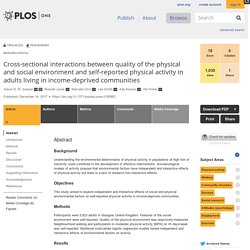
Socioecological models of activity propose that environmental factors have independent and interactive effects of physical activity but there is a lack of research into interactive effects. Objectives. Relationship between the physical and social environment and walking. Five key sustainability trends for 2018. 7 key trends all sustainability execs should watch. It is 2018, and it arguably never has been a more difficult, unpredictable, yet exciting time to run an international business. No doubt overcoming the Great Depression ahead of the outbreak of World War II in the 1930s was more than a little trying, of course. Five Trends Influencing the Future of Our Cities. When the U.S. Environmental Protection Agency removed its climate change hub from public view earlier this year, 17 cities had a response: Each posted the information on city government sites.
The move was symbolic of a quiet revolution: Environmental, social, and economic change is increasingly centered at the city level. Ecological And Social Trends Affecting Business In 2018. In this final post in our four-part series, we highlight ecological and social trends affecting business in 2018 and beyond.
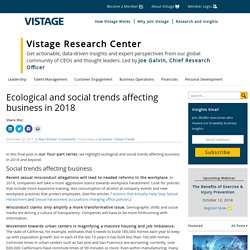
Social trends affecting business Recent sexual misconduct allegations will lead to needed reforms in the workplace. In 2018, companies will take a more aggressive stance towards workplace harassment. Look for policies that include more expansive training, less consumption of alcohol at company events and new workplace practices that protect employees. (See the articles 7 Actions that Actually Help Stop Sexual Harassment and Sexual harassment accusations changing office policies.)
We Are Social's trends to watch in 2018. Disruptive innovations and emerging technologies are constantly changing the digital landscape.

The challenge for brands is to adapt their offering to remain relevant in this fast-paced environment. Our leadership team from across We Are Social’s ten offices have identified the key trends that brands should watch out for, and how they will shape the marketing industry in 2018. Nathan McDonald, Co-Founder and CEOThe evolution of direct messenger marketing The evolution of messaging services is set to continue. As our social feeds become ever more cluttered, we look to more private channels – direct messages – for connection to others. And the more time we all spend in messaging environments, the more important it is for brands to define how they can add value in this environment. Foresight emerging trends 2017 au. 5 societal changes that will shake up business. 1.
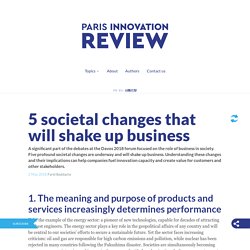
The meaning and purpose of products and services increasingly determines performance Take the example of the energy sector: a pioneer of new technologies, capable for decades of attracting the best engineers. The energy sector plays a key role in the geopolitical affairs of any country and will be central to our societies’ efforts to secure a sustainable future. Yet the sector faces increasing criticism: oil and gas are responsible for high carbon emissions and pollution, while nuclear has been rejected in many countries following the Fukushima disaster.
Societies are simultaneously becoming ever more energy-intensive and increasingly concerned with decarbonization. For more and more employees, including the most highly-qualified, loyalty to a company is no longer a given. The energy sector achieves low margins on its finished products (the retail sale of energy in all its forms). 2. Energy companies are on the front line. 12 Emerging Global Trends That Bring Hope for 2018. Global risks in the face of social, environmental and technological change. Global risks related to key social, environmental and technological trends are creating an interconnected web that continues to sow considerable uncertainty for humanity going forward. Migration, climate change and weapons of mass destruction are expected to leave the riskiest mark on governments and businesses globally. The world faces considerable uncertainties in the face of rapidly developing technologies, increasing income inequality, social polarisation and environmental degradation.
In a new report from the World Economic Forum, in strategic partnership with Marsh & McLennan Companies and the Zurich Insurance Group, the current largest scale risks facing the world are explored. The 12th edition of the ‘Global Risk Report’ involved 745 ‘world leaders’ from, among others, business, academia, and NGOs. Europe's regional inequality from 1900 to today. Growing inequality in terms of personal income and wealth distribution is a major concern, as shown by the work of Atkinson (2007), Piketty (2014), and Milanovich (2016).
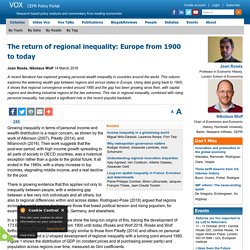
Their work suggests that the post-war period, with high income growth spreading to all parts of society in OECD countries, was a historical exception rather than a guide to the global future. It all ended in the 1980s, with a sharp increase in top incomes, stagnating middle income, and a real decline for the poor. Scientists study how environmental and social change affects the spread of infection - News - Medical Research Council. West Nile fever grips Southern and Central Europe. The number of West Nile virus infection cases in Europe has gone up in 2018, with increased temperatures to blame. The biggest number of cases has been registered in Serbia, the World Health Organisation (WHO) has revealed. EURACTIV Serbia reports. By mid-August, 401 cases of West Nile fever in humans have been registered in European countries, with 22 deaths recorded, according to the European Centre for Disease Prevention and Control (ECDC). The ECDC data shows that the biggest number of cases has been reported in Serbia (126), followed by Italy (123), Greece (75), Hungary (39), Romania (31), France (3), Croatia (2) and Kosovo (2).
‘It’s the housing, stupid’: How homes harm our health. Most of Europe’s buildings are more than forty years old and are largely inefficient. Poorly insulated, leaky buildings have a real impact on inhabitant and worker health, according to the latest edition of the Healthy Homes Barometer. One out of six Europeans report living in an unhealthy building, with factors like leaky roofs, damp, inadequate natural light and poor temperature control all affecting well-being. That means nearly 90 million people in this part of the world alone live in what can be described as inadequate housing.
Two-thirds of building stock is more than four decades old and only 10% can be graded A or B in energy performance certification. Currently, that problem is not being dealt with effectively because annual renovation rates do not exceed 2%. EU energy chief Maroš Šefčovič said that “it is essential that we base our decisions on well-founded, comparable and reliable data. Indoor air quality sneaks into EU buildings law review. Poor housing linked to rising asthma cases in Europe. One in six Europeans – equivalent to the entire population of Germany – live in a damp or mouldy building, which increases their chances of getting illnesses such as asthma, according to a new study.
Europeans living in an “unhealthy” building – with a leaking roof, walls or foundations – are significantly more likely to report poor health, according to the 2017 edition of the Healthy Homes Barometer, to be unveiled on Wednesday (31 May). Failure to act swiftly on climate change risks human rights violation on massive scale. Researchers explore psychological effects of climate change. Wildfires, extreme storms and major weather events can seem like a distant threat, but for those whose lives have been directly impacted by these events, the threat hits much closer to home.
Climate change linked to depression. Depression and anxiety afflict Americans who are concerned with the fate of the environment, according to a study of the mental health effects of climate change. Most hard-hit are women and people with low incomes who worry about the planet's long-term health, said the study published this week in the journal Global Environmental Change. Guest post: The impact of climate change on mental health is impossible to ignore.
What psychological science can offer to reducing climate change. For some years, there is a good deal of consensus among scientific experts that climate change is real, and that it is caused by human behavior. Social vulnerability and environmental migration: The case of Miyagi Prefecture after the Great East Japan Earthquake. Climate Change Is Going to Drive Thousands of Refugees to Cooler Countries – Futurism. Experts concerned about equity gap in environment-related morbidity and mortality. To discuss the latest evidence on the magnitude of environmental inequalities, European experts on environmental health equity met on 23–24 May 2017 in Bonn, Germany. Neighborhood deprivation and biomarkers of health in Britain: the mediating role of the physical environment. This study contributes to the literature by empirically testing whether multiple physical environment characteristics explain the association between neighborhood socioeconomic deprivation and a set of objectively measured health outcomes.
How social equality is linked to health, as manifested in the built environment. Is a clean river fun for all? Recognizing social vulnerability in watershed planning. Citation: Cutts BB, Greenlee AJ, Prochaska NK, Chantrill CV, Contractor AB, Wilhoit JM, et al. (2018) Is a clean river fun for all? Why Air Pollution Is a Socioeconomic Issue. I Can’t Breathe: Air Pollution Widens Gap of Income Inequality in the U.S. - Tepper School of Business.
Impact, efficiency, inequality, and injustice of urban air pollution: variability by emission location. Air Pollution Contributes to Health Disparities. Pollution has higher impact in deprived areas. Health status and air pollution related socioeconomic concerns in urban China. Disease and Health Inequalities Attributable to Air Pollutant Exposure in Detroit, Michigan. Pollution and health inequality. Gender inequality a significant barrier to development. Geography and Environmental Inequality - GeoLounge: All Things Geography. The social and health impacts of inequality and our current economic system. Ecological Sustainability, Inequality and Social Class - The Bullet. How does social inequality affect the environment? Environmental Inequality: The Social Causes and Consequences of Lead Exposure.
Adverse effects of indoor air pollution on child health to be investigated in first ever UK review. Urban noise pollution is worst in poor and minority neighborhoods and segregated cities. Air pollution inequality widens between rich and poor nations. Does living near wind turbines negatively impact human health? Yale-Led Study to Examine Health Disparities in Senior Population. Gender and Social Equality. Gender equality and the environment Guide to UNEPs work 2016 (1) The rich, the poor and the earth. How to break down discrimination barriers for women in agriculture. Worldwide study: Women say gender discrimination persists in agriculture. How Social Justice and Environmental Justice Are Intrinsically Interconnected. GWI Social Summary Q3 2017. Corporate citizenship and social impact. Social Media and Disasters: Highlighting Some Wicked Problems - IEEE Technology and Society. Isprs archives XLII 3 W4 75 2018. The ‘Eco-Friendly’ Trend is Affecting the Way Brands Appeal to Consumers.
Options for keeping the food system within environmental limits. The New Look of Behavioral Genetics in Social Inequality: Gene‐Environment Interplay and Life Chances - Spinath - 2017 - Journal of Personality. The role of gifts in reestablishing personal and social identity. What causes crime? Social acceptance and perceived ecosystem services of urban agriculture in Southern Europe: The case of Bologna, Italy. Risk to Europe's most dangerous pathogens revealed. First smallpox treatment approved amid fears of 'weaponised' virus. Europe's meat and dairy production must halve by 2050, expert warns. Where has all the sperm gone? The Economics of Environmentalism. MPs to examine environmental footprint of UK fashion industry. Artificial sweeteners have toxic effects on gut microbes. Global market for bike-sharing services to grow 12.5% per year until 2026. Fodder shortage fears sparks panic buying amongst farmers - FarmIreland.ie.